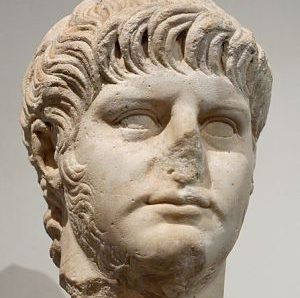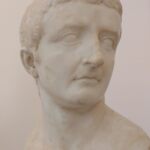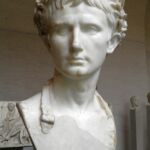Chapters
This dynasty ruled from 27 BCE until 68 CE. Its founder was Octavian Augustus.
It took its name from gentes of the first two emperors. It maintained an appearance of cooperation with the senate, the ruler initially called himself princeps. It was based on the army and equites, which were often of great importance. The times of the Julio-Claudian dynasty were a period of formation of the state apparatus and professional administration.
Octavian Augustus
Gaius Iulius Caesar Octavianus (63 BCE – 14 CE)
Son of Gaius Octavian and Atia the Elder, grandson of his sister Julius Caesar and son of Caesar adopted by will. He apparently did not change the republican system, but concentrated in his hands all the actual power, becoming the first senator and high priest.
Octavian carried out a number of political reforms. He reduced the number of senators to 600, instituted a new property census, introduced new taxes, cared for the development of Rome, and supported art. He reorganized the military; in the management of provinces, he divided into imperial and senate provinces.
In general, the years of Octavian’s reign were a period of internal peace and economic boom, and wars were fought only on the periphery.
Biography of Octavian Augustus
Tiberius
Tiberius Claudius Nero (42 BCE – 37 CE)
His assumption of power was sanctioned by a special resolution of the Senate. He was a suspicious man, but a capable commander and administrator. He introduced inspections of officials in the provinces to prevent abuses.
During his reign, his nephew Germanicus undertook a series of victorious expeditions against the Germans but was soon recalled by Tiberius to Rome. For the sudden death of Germanicus in 19 CE Tiberius was accused. Fearing for his life, he brought a number of lawsuits for insulting the majesty, ending with death sentences. He made Sejanus, the prefect of praetorians, his assistant, and from 26 he lived on the island of Capri, giving orders by correspondence.
He died in 37 CE when Caligula probably strangled him in his own bedroom.
Caligula
Gaius Iulius Caesar (12 – 41 CE)
The early years of Caligula’s reign were prudent and did not signal any diametric change.
However, in October 37 CE the emperor fell on quite a serious disease, probably of the brain. When Caligula recovered, he was a different man. He began a very cruel rule, demanding divine worship for himself. He was murdered by conspirators.
Claudius
Tiberius Claudius Drusus Nero (14 BCE – 54 CE)
He was elevated to the throne by chance by the praetorians. He was a man with a scientific interest. He showed great abilities as a ruler. He strengthened the imperial power while tightening relations with the senate, expanding the bureaucracy; the inhabitants of the province were widely granted Roman citizenship. Claudius, wanting to gain military credibility, undertook an expedition to Britain in 43 CE. After returning to Rome, he celebrated his triumph in 44 CE.
Characteristic for the reign of Claudius is the increasing role of the liberators in exercising power. The emperor, distrusting the senatorial circles, entrusted the liberationists with the main role in the administration and in the council. Few of them; Tiberius Claudius Narcissus, Tiberius Claudius Polybius and Pallas gained a very influential position.
He built, among others a new port in Ostia and an aqueduct in Rome, and conquered Great Britain.
Nero
Tiberius Claudius Nero Caesar Drusus (37 – 68 CE)
This emperor ruled as the fifth consecutive emperor and went down in history as one of the tyrants of Rome.
The power-hungry Nero, only seventeen years old at the time of assuming power, sought to impose Hellenistic forms of exercising power, constantly competed with the senate for influence, and even subjected himself to deification in the final period of his reign. Due to this conduct, he was perceived as a tyrant among the Roman aristocracy.
He committed suicide when Galba proclaimed himself emperor in Spain in 68 CE.
Family tree of the Julio-Claudian Dynasty
Previous dynasty: | Next dynasty: |












